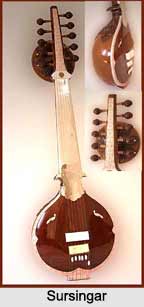 Sursingar was a string musical instrument that appeared in Indian music in the early 19th century, as an improved version of the Seniya rabab and analogous with the Surbahar.
Sursingar was a string musical instrument that appeared in Indian music in the early 19th century, as an improved version of the Seniya rabab and analogous with the Surbahar.
Etymology of Sursingar
The Sursingar is also known as `sursringar` or `surshringar`, signifying pleasure of melodious music in Sanskrit.
Design of Sursingar
The Sursingar was the instrument meant to play the Hindustani meditative Dhrupad style of North Indian classical music. Its design was a modified developed one to that of a rabab, which had certain limitations because of the gut strings and skin parchment upon the resonator.
The design of a Sursingar incorporated a wooden sound board replacing the skin parchment of resonator. The strings were made of steel and bronze. The fingerboard in a Sursingar had been coated with a thin iron sheet. These modifications in the design made the Sursingar distinctively superior to the rabab, in terms of the tonal quality, the resonance and for the Dhrupad style. These modifications in the rabab were carried out by a descendants of Tansen, Jaffar Khan.
Like the Surbahar, the body of the main box of Sursingar is made from a pumpkin cut open horizontally and covered with wood, onto which a flat horn bridge is placed. It has a second sound box and the steel and bronze strings are played with a metal pick.
It reminds of a sarod, for its metal fingerboard but is much larger in size and also produces a deeper sound. It precedes the sarod chronologically.
The mechanism for producing the sounds is formed by the main box or gourd body, attached to the fingerboard. The metal covering on the fingerboard facilitates the glissando (glide from one pitch to other). It has four main strings and four rhythmic drones.
Sursingar instrument was well-suited for `vilambit alap` (the improvised slow prologue in typical North Indian classical music performance). It was also played with the support of the left shoulder, as the Veena. Techniques of both veena and rabab could be incorporated in it. The melodious effect of Sursingar was so overpowering that it could even outshine the veena in its `vilambit alap`.
The instrument was well received in the world of music and became popular in a very short time in northern India. Both the sursingar and surbahar were meant to play the Dhrupad alap, in their splendid elaborate fashion. Sarod players used to play alap on the Sursingar before playing `gat toda` on sarod in the same manner as sitar players used to play on the surbahar before playing `gat toda` on sitar. Thus it became customary to practise the sursingar along with the sarod, till the early years of the twentieth century. Gradually as the sarod and the sitar got modified and well equipped with greater range of expression, the popularity of the sursingar and the surbahar ebbed and they became obsolete and extinct by the latter half of the 20th century.
Notable Performers of Sursingar
Baba Allauddin Khan and Pandit Radhika Mohan Maitra were noted for their Sursingar recordings.




















